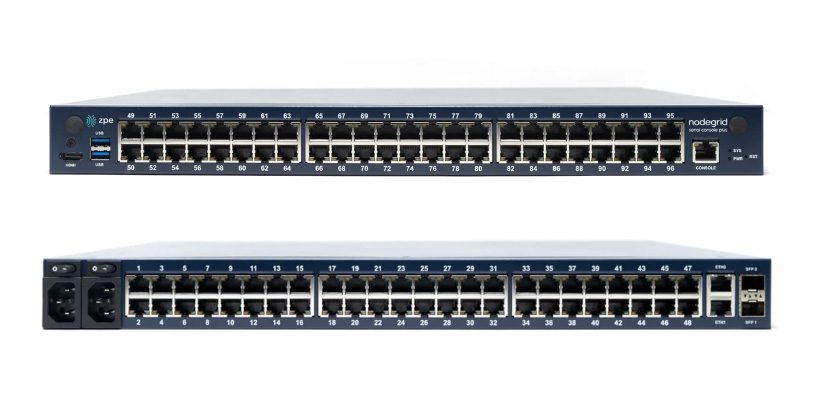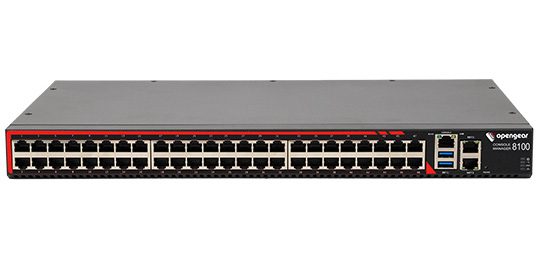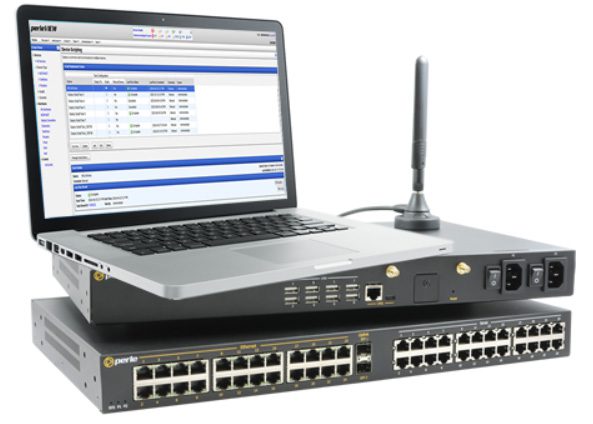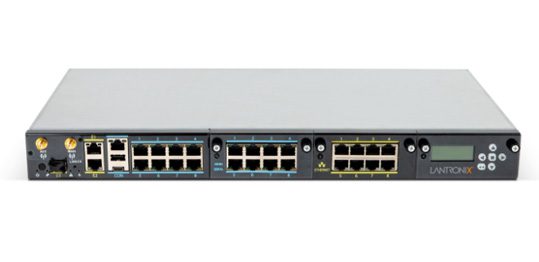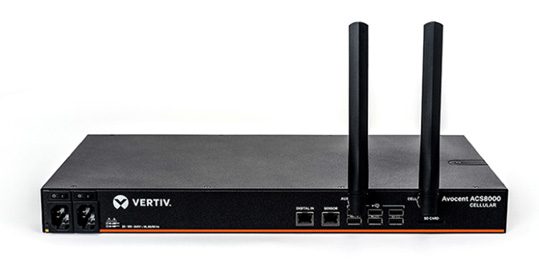
The serial console port on a Linux device allows administrators to manage the machine via the command line interface (CLI), without a keyboard, mouse, or monitor attached. Serial console management is useful for performing administrative tasks on headless Linux servers (meaning, those without ports for a keyboard or monitor) and embedded Linux systems like routers and storage devices.
While it’s possible to directly connect a laptop or Intel NUC jump box to the serial console port on a Linux device with a serial cable, this only allows you to manage one machine at a time, so it’s inefficient at scale. A serial console server (also known as a serial console or console server) provides multiple managed serial ports that administrators can connect to Linux machines, as well as many other devices. It unifies the management of all connected machines so administrators can control them all from one place, significantly streamlining infrastructure workflows.
Enterprise serial consoles for Linux provide additional capabilities like out-of-band (OOB) management, infrastructure automation, and embedded security. This guide compares the best solutions to help you choose the right console server for your enterprise.
Quick Links
How to use the serial console port on a Linux device
The Linux kernel does not support serial console capabilities by default, so it must be configured to output console messages to the serial port first. This involves modifying the bootloader to specify new kernel options, formatted like so:
console=device,options
device: tty0 for the foreground virtual console
ttyX for any other virtual console
ttySx for a serial port
lp0 for the first parallel port
ttyUSB0 for the first USB serial device
options: depend on the driver. For the serial port this
defines the baudrate/parity/bits/flow control of
the port, in the format BBBBPNF, where BBBB is the
speed, P is parity (n/o/e), N is number of bits,
and F is flow control ('r' for RTS). Default is
9600n8. The maximum baudrate is 115200.
For more information on configuring the Linux serial console, read guides from docs.kernel.org, RedHat, or Ubuntu.
Comparing the best serial consoles for Linux
| ZPE Nodegrid | Opengear CM8100 | Perle IOLAN SCG LWM | Lantronix LM83X | Vertiv Avocent ACS8000 | |
|---|---|---|---|---|---|
| Cellular OOB | ✔ | ✖ | ✔ | ✔ | ✔ |
| ZTP for End Devices | ✔ | ✔ | ✔ | ✔ | ✔ |
| Guest OS | ✔ | ✔ | ✖ | ✖ | ✖ |
| 3rd Party Automation | ✔ | ✔ | ✖ | ✖ | ✖ |
| Embedded Firewall | ✔ | ✔ | ✔ | ✖ | ✔ |
| 3rd Party Security | ✔ | ✖ | ✔ | ✖ | ✖ |
All of these solutions provide remote out-of-band management and consolidated control for Linux infrastructure. They also offer automation capabilities via zero-touch provisioning (ZTP), automatically deploying configurations over the network as soon as new devices come online. Some important differentiating features include cellular capabilities for OOB and failover, advanced security features like an embedded firewall and VPN support, and the ability to host and integrate third-party automation tools.
1. Nodegrid Serial Console
Nodegrid is a family of serial console server solutions from ZPE Systems. Nodegrid provides up to 96 managed serial ports while only taking up a single unit of rack space (Patent No. 9,905,980), significantly reducing the number of management devices needed to control large data center deployments. The Nodegrid Serial Console Plus (NSCP) comes with built-in 4G/5G LTE and Wi-Fi for failover and OOB management, while the S Series has auto-sensing serial ports for mixed legacy/modern environments. The NSCP-Core Edition is a low-cost alternative for break-fix deployments that provides Gen 3 security and OOB serial console management.
The Nodegrid platform runs on the open, Linux-based Nodegrid OS and uses Intel x86 processors, allowing it to natively run VM and Docker applications for other vendors’ software. That means you can host third-party NetOps automation solutions like Ansible and Chef, and even extend that automation to legacy equipment. Nodegrid also provides device auto-discovery and ZTP.
Nodegrid serial consoles include an embedded firewall with a multi-site IPsec VPN and advanced authentication support to protect the OOB network. It also comes with unique hardware security features like geofencing, BIOS protection, and UEFI Secure Boot to prevent malicious actors from hijacking the management network with a stolen device.
Pros:
|
Cons:
|
Opengear CM8100
The Opengear CM8100 serial console has up to 48 ports in a 1U model or 96 ports in a 2U model. It only uses Ethernet for failover and OOB, without any options for cellular or Wi-Fi. It runs an embedded Linux operating system that is programmable and extensible with third-party integrations.
With an upgraded “Automation” edition of its Lighthouse software, Opengear console servers gain ZTP, RESTful APIs, Docker containers, and Python scripts for infrastructure automation capabilities. The CM8100 comes with a stateful firewall that provides IP filtering and port forwarding. It supports IPsec & OpenVPN and advanced authentication, but not 2FA or SAML 2.0.
Pros:
|
Cons:
|
Perle IOLAN SCG
The Perle IOLAN SCG serial console supports up to 48 managed serial ports. While its fixed-form-factor models only support copper Ethernet for networking and OOB, the SCG also has a modular version with options for Wi-Fi, cellular, and analog modem.
IOLAN SCG console servers contain an underpowered 500 MHz core 32-bit ARM processor and little storage or memory headroom for automation, though Perle’s management software can extend ZTP to end devices. The solution does include a robust embedded firewall and support for two-factor authentication.
Pros:
|
Cons:
|
Lantronix LM83X
The Lantronix LM83X serial console is a modular solution with three expansion bays, supporting up to 104 managed serial ports. It has versatile options for 4G LTE, analog modem, fiber, DSL, or satellite for OOB and failover.
The LM83X’s ARM CPU architecture prevents it from running VMs and Docker containers for automation or third-party software. The Lantronix Control Center software does not support any third-party integrations, though it does provide some built-in automation and playbook capabilities. The LM83X offers some advanced authentication support and IP filtering but lacks an embedded firewall or VPN.
Pros:
|
Cons:
|
Vertiv Avocent ACS8000
The Vertiv Avocent ACS8000 provides up to 48 managed serial ports, with faster-than-average minimum port speeds of 1200 bps. It uses 4G LTE for OOB and failover and has an updated Linux operating system.
While the ACS8000 has ZTP for end devices, its ARM architecture does not support VMs, Docker apps, or third-party automation and orchestration. The proprietary DSViewTM software offers some automation capabilities for event logging and notifications but is not extensible with third-party integrations. The ACS8000 has an embedded firewall and IPSec VPN support, but lacks advanced authentication features.
Pros:
|
Cons:
|
How to choose the best serial console for your Linux environment
These solutions all provide remote out-of-band management and consolidated infrastructure control for Linux devices. However, Nodegrid goes above and beyond by offering a truly vendor-neutral platform that supports third-party integrations and direct hosting of other vendors’ automation and orchestration software. Plus, only Nodegrid secures the automated control plane with robust on-board hardware security protection and a full suite of firewall, encryption, and authentication features like 2FA and SAML.
Ready to replace your outdated console servers?We know that replacing outdated, EOL devices takes a lot of effort. That’s why ZPE now offers a complete package of budget-friendly products and engineering services to help. Click here to see how we make it easy to upgrade to the best serial console for Linux. |
Which Nodegrid serial console is right for you?
| NSCP | S Series | NSCP-CE | NSR | |
|---|---|---|---|---|
| Use Cases | Hyperscale data centers and cloud service providers | Mixed legacy, modern, and multi-vendor environments | Break-fix solution for data centers, colocations, and branches | Modular and adaptable to any use case |
| Serial | 16 / 32 / 48 / 96 | 16 / 32 / 48 | 16 / 32 / 48 | 16 / 32 / 48 / 64 / 80 |
| Network | 2 SFP+ & 2 ETH | 2 SFP+ or 2 ETH | 2 SFP & 2 ETH | 2 SFP+ & 2 ETH |
| CPU | Intel x86_64 quad core | Intel x86_64 dual core | Intel x86_64 dual core | Intel x86_64 quad core or 8-core |
| Guest OS | 1 | 1 | 0 | 1-6 |
| Docker Apps | 1-2 | 1-2 | 0 | 1-4 |
| Storage | 32GB SSD | 32GB SSD | 16GB SSD | 32GB – 128GB |
| RAM | 4GB DDR4 | 4GB DDR3 | 4GB DDR4 | 8GB DDR4 |
| Wi-Fi | Optional | Optional | Optional | Optional |
| Cellular | Optional | Optional | Optional | Optional |
| Power |
Single or Dual AC Dual DC |
Single or Dual AC Dual DC |
Dual AC Dual DC |
Single or Dual AC Dual DC |
| Data Sheet | Download | Download | Download | Download |

